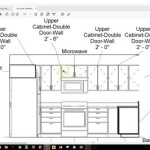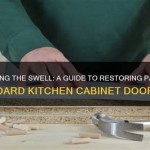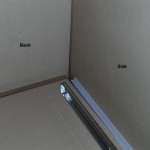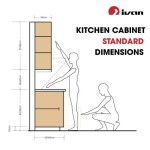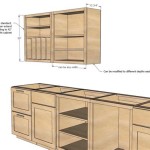Refinishing Formica Kitchen Cabinets: A Comprehensive Guide
Formica kitchen cabinets were a popular choice for decades, prized for their durability, affordability, and ease of cleaning. However, styles change, and Formica, while resilient, can become dated or damaged. Refinishing offers an alternative to complete cabinet replacement, allowing homeowners to update the look of their kitchens without a significant investment. This article details the process of refinishing Formica kitchen cabinets, providing a step-by-step guide to achieve a professional-looking result.
Surface Preparation: The Foundation for a Flawless Finish
The key to a successful Formica refinishing project lies in meticulous surface preparation. A poorly prepared surface will compromise the adhesion of any primer or paint, leading to chipping, peeling, and an overall unsatisfactory finish. This stage is arguably the most time-consuming but also the most critical.
Cleaning: The initial step involves thoroughly cleaning the Formica surface. Years of accumulated grease, grime, and cooking residue must be removed. Use a strong degreaser specifically designed for kitchen surfaces. Apply the degreaser according to the manufacturer's instructions, allowing it to dwell for the recommended time to effectively break down the contaminants. Rinse the surface thoroughly with clean water, ensuring no residue remains. Dry the cabinets completely with clean cloths.
Sanding: While Formica is a smooth, non-porous material, creating a key for the primer to adhere to is crucial. This involves sanding the surface to create microscopic scratches. Use a fine-grit sandpaper, typically between 220 and 320 grit. Avoid coarse sandpaper, as it can damage the Formica surface. Sand lightly, focusing on creating a uniform, dull sheen across the entire surface. Focus on edges and corners, ensuring these areas are also adequately prepared. Sanding should not remove the Formica laminate; it is only meant to etch the surface.
Repairing Damage: Before proceeding, assess the cabinets for any damage, such as chips, scratches, or delamination. Small chips can be filled with an epoxy-based wood filler or a specialized laminate repair filler. Apply the filler according to the manufacturer's instructions, ensuring it completely fills the damaged area. Allow the filler to dry completely, then sand it smooth and flush with the surrounding surface. For more significant damage, such as delamination, professional repair may be necessary. Delamination occurs when the Formica laminate separates from the underlying substrate. This can often be repaired by carefully re-gluing the laminate using a contact adhesive and clamping it until the adhesive cures.
Masking: Protect surrounding surfaces that are not being painted, such as countertops, walls, and appliances. Use painter's tape to carefully mask off these areas. Use plastic sheeting or drop cloths to cover floors and any furniture in the vicinity. Proper masking will save significant time and effort cleaning up unintentional paint splatters.
Priming: Bridging the Gap Between Formica and Paint
Priming is an essential step in refinishing Formica cabinets. Formica's non-porous surface is notoriously difficult for paint to adhere to directly. A primer acts as a bonding agent, creating a surface that paint can grip effectively. Selecting the correct primer is as important as surface preparation.
Adhesion Primer: The best primer for Formica is an adhesion primer, specifically designed to bond to slick, non-porous surfaces. These primers contain additives that create a strong mechanical bond with the Formica, providing a solid foundation for the topcoat. Look for primers labeled as "bonding primers" or "adhesion primers." Oil-based adhesion primers offer exceptional bonding properties but have longer drying times and require mineral spirits for cleanup. Water-based adhesion primers are easier to clean up and have lower VOCs (volatile organic compounds) but may require more coats for optimal adhesion.
Application: Apply the primer in thin, even coats using a high-quality brush, roller, or sprayer. Avoid applying thick coats, as this can lead to drips, runs, and uneven drying. A brush is suitable for detailed areas and corners, while a roller is efficient for larger, flat surfaces. If using a sprayer, follow the manufacturer's instructions for thinning the primer and adjusting the spray pattern. Allow the primer to dry completely according to the manufacturer's instructions, typically 24 hours. Lightly sand the primed surface with fine-grit sandpaper (320-400 grit) to smooth out any imperfections and further enhance adhesion. Remove any sanding dust with a tack cloth.
Tinted Primer: Consider using a tinted primer that is close in color to the final paint color. This can improve the coverage and vibrancy of the topcoat, especially if you are painting the cabinets a light color over a dark Formica surface. Tinted primers reduce the number of topcoats needed to achieve full coverage, saving time and paint.
Painting: Applying the Finishing Touches
Once the primer has dried and been properly sanded, it's time to apply the paint. Selecting the right paint type and applying it correctly are critical to achieving a durable and attractive finish.
Paint Selection: Choose a high-quality paint specifically formulated for cabinets. Acrylic latex paints are a popular choice due to their durability, ease of cleaning, and low VOCs. Alkyd paints (oil-based) offer a harder, more durable finish but have longer drying times and require mineral spirits for cleanup. For kitchen cabinets, a satin or semi-gloss finish is recommended. These finishes are durable, easy to clean, and resist moisture and grease. Avoid flat or matte finishes, as they are more difficult to clean and can show fingerprints and stains easily.
Application: Apply the paint in thin, even coats using the same method as the primer (brush, roller, or sprayer). Avoid applying thick coats, as this can lead to drips, runs, and uneven drying. Allow each coat to dry completely according to the manufacturer's instructions, typically 4-6 hours. Lightly sand between coats with fine-grit sandpaper (400-600 grit) to smooth out any imperfections and create a smoother surface for the next coat. Remove any sanding dust with a tack cloth. Apply at least two coats of paint for optimal coverage and durability. For lighter colors or surfaces with significant color differences, three coats may be necessary.
Spraying Techniques: If using a sprayer, practice on a piece of cardboard or scrap material to get a feel for the spray pattern and paint flow. Hold the sprayer at a consistent distance from the surface and move it in smooth, even strokes, overlapping each pass slightly. Avoid holding the sprayer in one spot for too long, as this can cause runs and drips. Several thin coats are better than one thick coat when spraying.
Brush and Roller Techniques: When using a brush, use a high-quality synthetic brush designed for latex or alkyd paints. Apply the paint in smooth, even strokes, following the grain of the Formica (if any). Avoid overloading the brush with paint, as this can cause drips and runs. When using a roller, use a short-nap roller cover designed for smooth surfaces. Apply the paint in a "W" or "M" pattern, then roll over the area to smooth it out. Avoid pressing too hard on the roller, as this can create stippling or orange peel texture.
Curing Time: After applying the final coat of paint, allow the cabinets to cure completely before reassembling them and putting them back into use. Curing is different from drying; it refers to the process where the paint hardens and becomes more durable. Refer to the paint manufacturer's instructions for the recommended curing time, which can range from several days to a week. Avoid placing heavy objects on the cabinets during the curing process. After the curing period, your refinished Formica cabinets should be ready for years of use.

How To Paint Laminate Kitchen Cabinets Perfect Finish Tips

Can You Paint Formica Kitchen Cabinets The Picky Painters Berea Oh

A Year In Review Of How I Painted My Laminate Cabinets With Two Methods

How To Refinish Your Kitchen Cabinets

How To Refinish Formica Cabinets Unique Chalk Paint Recipe Do It Yourself Fun Ideas

How To Paint Formica Countertops Step By 2024

Painting Kitchen Cabinets Without Primer

How To Paint Laminate Cabinets Everything You Need Know

How To Paint Laminate Kitchen Cabinets White

How To Add Trim And Paint Your Laminate Cabinets
Related Posts

